WHEN THE BOAT COMES IN
WHEN THE BOAT COMES IN
by Norman Warwick
Julie, my boss at Lanzarote Information, for which I also write a weekly column, has previously written in the on-line magazine that:
We love nothing better than a fresh fish lunch eaten at a restaurant situated over-looking the sea somewhere along the coast in Lanzarote. Most of the time we leave which fish of the day up to the waiter and we’ve yet to be disappointed.
The Spanish name of the fish often bears no resemblance to the English equivalent so we’ve shortlisted a few of the more common ones found on menu’s in Lanzarote* to help you decide what to order.
One of the strangest fish we’ve eaten in Lanzarote is called cantarero, it was served to us twice recently. The first time we were enjoying Sunday lunch in the small coastal village of Arrieta in the North, Restaurante El Charcon sits on the harbour overlooking the dolls house. We told the waiter we’d like fresh fish of the day but served fried and he suggested cantarero, simply prepared with the sides scored and deep fried it was delicious. Later when we looked up the name we found out we’d just eaten a plate of scorpion fish! Not the most handsome of the species but definitely very tasty.
I was offered cantarero a week or two afterwards at Restaurante Playa Quemada, situated in the South of the island on a black beach. The waiter could only translate it as a local fish when I questioned if this, too, was a scorpion fish. This time it was served open and grilled with slices of toasted garlic on top, it was lovely but not quite as nice as the deep fried version I’d eaten previously.
El Golfo is a popular destination for fresh fish lunches, there are a plethora of restaurants to choose from in this seaside village nestled between Timanfaya and Playa Blanca. Waiters will call to you in the street to try and tempt you into their restaurant to eat the fresh catch of the day.
- those other fish that Julie mentioned include
Cantarero – scorpion fish
Cherne – stone bass
Dorada – sea bream
Gambas – shrimps
Gueldes – whitebait
Langostinos – prawns

Lapas – limpets (left)
Lenguado – sole
Lubina – sea bass
Mejillones – mussels
Merluza – hake
Mero – grouper
Morena – moray eel

Medregal – amberjack (right)
Pez Espada – swordfish
Pulpo – octopus
Sama – red sea bream
Vieja – parrot fish
The fresh fish of the day has often been caught by a small one or two man boat in the waters in front of the restaurant and has been gutted and cleaned on the nearby rocks, usually causing a Hitchcockian feeding frenzy of seagulls over the scraps!

I was reminded of this article of Julie´s when ´recently reading an interview in Lanceleot Digital, one of the island´s best known news providers, with Domingo Delgado Morin (left) , The Honorary Advisor of the Spanish Fishing Industry, expressed the view that to remind inhabitants, and tourists, of all that the local fishing industry has given first to the survival of the island, and then to its growth and sustainability, it is deserving of a dedicated museum.
To make his point he looked back on the past forty five years of his life in the fishing industry.
I started working with the fishing sector in the Fishermen’s Association in 1979. At that time, there was a national purse seine fleet based in Lanzarote and a large number of industrial complexes were already parading around the island. And why in Lanzarote? Fishermen came from other ports, especially from those in the north and south of the peninsula through the fishing ground of the Saharan Canary bank, which was where the sardines were and the closest point was Lanzarote.
The canning industries soon became essential for the island economy… and I look back and remember thefishing boom in Lanzarote in those years when we had seven industrial complexes. I recall that the phenomenon of the time is that in the fishing industries there were more women than men, who went fishing. They were more delicate to treat sardines. We got to have more than 55 fishing boats dedicated to sardines. Later they grew in length and there were fewer boats, but bigger ones. Entire families from the island and from Fuerteventura worked on the boats and in the canneries.
Many of the boats were from and owned by the canneries themselves, but the crews were from here. Fishing was fundamental to the economy of the island. It is an essential part of our history. The importance of fishing on the island was so great that, thanks to it, Arrecife was created. A lot of people laugh when I say that, but it’s true, Arrecife didn’t exist. Arrecife began to form thanks to the fishermen who came to the Morro de la Elvira, to the Charco de San Ginés, to build their little houses, and the coastal fishing began to gather population. And then the buildings were made and the city was formed.
The decline really began when when Spain entered Europe, it soon began to dawn on us that these fishing agreements between the EU and the countries in the area were very expensive and only benefited us, Spain, Portugal and little else. So the premiums for scrapping were increased and a very clear light was lit for our shipowners: apartments and hotels. And that was what happened… There was a ship, the Itchan Norte, which was one of the largest that passed through the island, it came from the Basque Country and had a capacity of 1,010 tons. That ship, when she led the decline of all this, when she was scrapped, she obtained a thousand and something million of the old pesetas. She had a sweet tooth.
I think it has become very clear now with the covid pandemic that things were done wrong in the past. Since the only thing on the island is tourism, since all the eggs are in the same basket, the island was completely paralyzed. The economy stopped working. Things didn’t go well back in the day. We cannot all dedicate ourselves to the same thing, there must be alternatives. I, as an honorary advisor to the Spanish Association of Fishing Cities, travel a lot and see how i–n many cities on the Spanish coast there are small companies that sell artisanal canned seafood products, complying with all health requirements. They are small industries that do not pollute and diversify. There is an FAO study that says that one job on a ship generates another five jobs on land due to the multiplier effect it has.
It is difficult to claim that-the fishing sector on the island has been worthily maintained. Right now there are no sardines left and only six tuna boats that, in my opinion, deserve a monument. Every time I have the opportunity to talk to a politician, I always say the same thing: help the tuna boats, don’t leave them alone because the community regulations put a lot of obstacles in their way. Tuna is a highly migratory species, the cathedral of reproduction of tuna is in the Mediterranean and when they are older they go through the Strait, they are located in Madeira and Azores, and depending on the temperature of the waters they go down to the Canary Islands. And if they don’t fish here, they go to Africa. Our tuna boats are totally artisanal boats that catch the pieces, one by one, and are only interested in the large pieces. The Koreans, for example, purse seine and trawl and end up with large tuna and pups, and everything they catch. Our tuna vessels are pole-and-line tuna vessels because they fish them with rods, one by one. The truth is that professional fishermen are attacked from all sides, they cannot fish in the Marine Reserve, for example, because the species must be protected and then they give 2,000 sport fishing licenses for tourism. Hopefully, after what happened with the pandemic, they reflect and diversify the economy.
A logical evolution should have been the fish farms and aquaculture, butin Lanzarote, the Playa Quemada cages were authorized for the fattening of tuna, which feed on small fish, and it is totally clean, but the businessman failed. So he changed the production to sea bream and sea bass, which is cheaper because feed is used, and therefore, chemical products. Between that and the excrement they generate, the contamination of the waters that we already know has occurred. If they had left them for tuna, nothing would have happened.
I don´t think the acquaculture if for tourist destinations. That’s exactly what I’m saying. The first thing to do is study the area and its currents in detail. The bottom of these marine cages must be five meters, and great care must be taken with feeding and cleaning the area. You have to calculate the currents very well so that they do not carry possible dirt to the beaches. Another option would be inland aquaculture, which I have seen in many places and is successful and is carried out using salt flats. It would only be necessary to properly train the cookers, for sea bream and sea bass, or for the species that are decided, always with the precise sanitary control. It is an option, not only feasible, but also attractive from a tourist point of view. It could be done in the salt flats of Arrecife, in the ones below the cliff,
It is important to keep the historical memory of the island alive, in this sense, and I believe there is a budget to set up a Fishing Museum on the island, Why hasn’t it been done?
Whilst head of services of the Fishing Department of the Cabildo de Lanzarote, I worked hard to make a project for a fishing museum because I have always thought that if there is an island in the Canary Islands that deserves a museum for its trajectory and its history , that’s Lancelot. Some Catalan technicians came to do the proper study. It was thought at that time to do it in the old building of the Frigorsa factory. The project was measured and made. The idea was to divide it into three parts: exhibit all the pieces we had, including the Santa Teresa boat that museum visitors could board to see what a fishing boat was like inside; In addition, there was a room for extraordinary acts in which visitors and students from the island’s centers could be exhibited. videos of how the different species are fished on the high seas, from deep-sea fishing to surface and mid-water fishing; Upstairs there would be a large cafeteria, with little fish and seafood tapas… we spent about 60,000 euros on that project and it is tucked away in a drawer. In Brussels, moreover, there is money for the reconversion of the old factories into this type of centre, but we are not going to request it, I don’t know why.
The fishing sector in the Canary Islands will always be important. It is not understood that solutions have not been sought to modernize the fleet and adapt to the current situation. The shrimp from La Santa, which was not caught because it was not of interest, now has an astronomical price. There are many other species on the island that are not caught and are true delicacies. Let’s study what we have. Let’s not let the fishing sector die completely.
After all this talk of artisanship we would do well to remember that the work of our artists, both in preserving a past, and envisioning a future, could be of huge importance. in delivering on Domingo´s dream.
Nevertheless, all this is being spoken of in uncertain times.
Read Lampoon magazine, for an article headlined
SEASPIRACY. TRUTH OR LIES?
A closer look at Lanzarote’s fishing industry
check out https://www.lampoonmagazine.com/article/2022/01/16/seaspiracy-lanzarote-fish-farming/
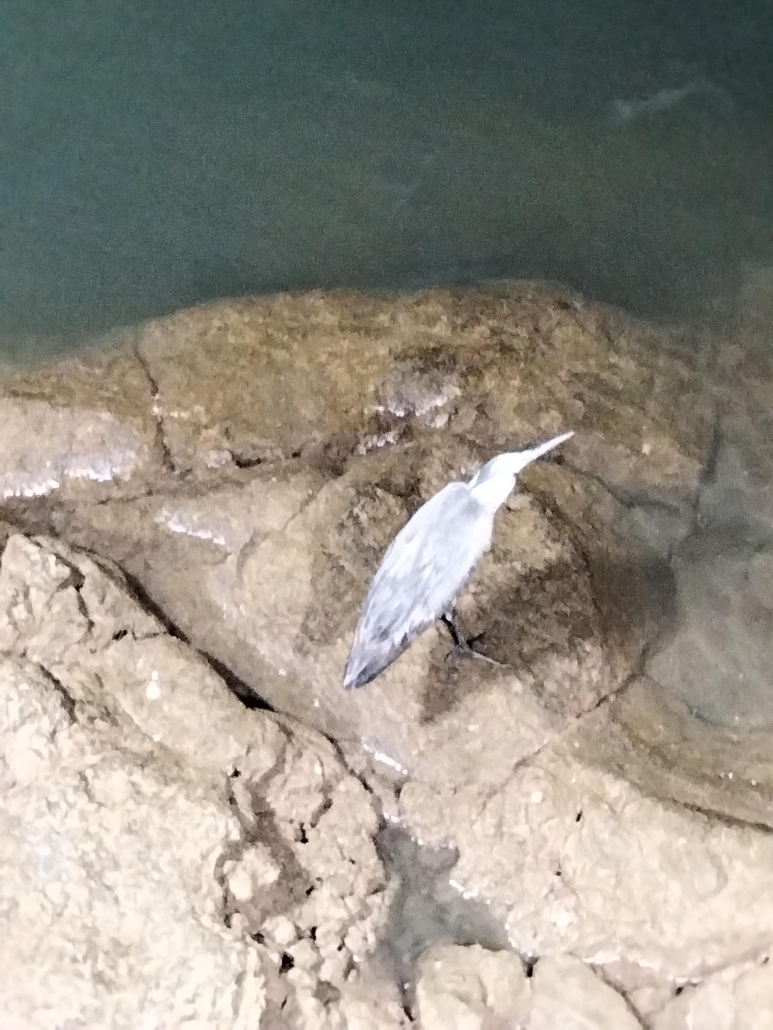
Unperturbed by all this talk of quotas, boat size, crew capacity, registered waters and other things that mankind worries about, is the somewhat graceless but ruthlessly efficient Grey Heron (right) currently making its home beneath the decking / bridge of Lani´s Snack Bar down at The Marina Rubicon in Playa Blanca.
Spending its day in the shade, below where we eat a couple of times a week, he (or she) only moves when hungry. With its long can-opener, I mean beak, and its splayed webbed feet it wobbles across when it sees pieces of bread falling into the water by diners feeding the fish. They might be a school but these fish never seem to learn their lesson and instead come in their hundreds, right up to the water´s edge to feed on crumbs from the tables. Old Grey Heron just dips his neck from time to time and picks out his three course lunch. That´s subsistence fish-farming and economy of cost and effort !
That Lanzarote cherishes its fishing industry is perhaps best revealed by the songs by the local folk lore musicians.
Similarly the rise and fall (that´s a tidal reference) of the UK fishing industry can be traced through the country´s folk songs.
It goes without saying then, that here at Sidetracks And Detours, we feel the urge to creat a playlist to reflect all that. Nor will it surprise you that we opne our playlist, entitled Songs of the Sea, with one of my own compositions.
Sixteen on The Water is a poem I wrote whilst on holiday on Lanzarote twenty years ago, long before I came to live here in 2015. In thoise days you would often see small fishing fleets moored in tiny harbours. As we drove down the east coast one day I counted sixteen such boats all of which had the name of a female in their title. I utilised all these names and used personification to turn the boats into those girls.
Singing The Fishing was created as the third in a series of Radio Balladsdeveloped by Charles Parker, Ewan McColl and Peggy Seeger for the BBC Home Service between 1958 and 1964, Singing the Fishing (1960) centres on the herring fishery of Great Yarmouth.
It is hard to imagine any connections between Great Yarmouth and <new York in the USA. Nevertheless, Inside Llewyn Davis, a movie by Joel and Ethan Coen, is a moody portrait of the US city’s folk scene in 1961. (I actually saw the film in the weirdly wonderful cinema in Todmorden about eight or nine years ago).
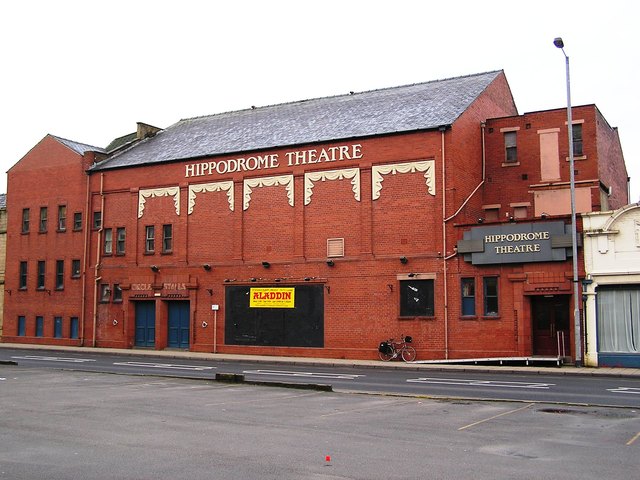
The Todmorden Hippodrome (left) opened as a live theatre on October 9, 1908 with “Two Lancashire Lasses in London”. Seating was provided for 1,500 in orchestra stalls, pit and balcony areas. By 1911 film interludes were part of the programme and by 1917 movies had all but taken over.
It is externally a plain red brick building slightly outside the town centre in Halifax Road, which has probably aided its survival. Inside however there is attractive Edwardian Baroque style plasterwork on the front of the balcony and around the proscenium arch. The auditorium remains very much as built with the exception that the former ‘pit’ (rear stalls seating beneath the balcony) has been walled off to form a large bar/foyer space for the theatre.
The Hippodrome was the first cinema in Todmorton to present the ‘talkies’ which arrived on 17 March 1930 (“Broadway Melody”), it was boasted at the time that it was the best installation in the north of England.
However it was also the first cinema in the town to close in June 1956 and was leased to the Todmorden Players and the Todmorden Operatic Societies who still own it. A huge amount of renovation work has been carried out over the years and the Hippodrome Theatre is a popular venue for local amateur and small scale professional theatrical productions. It now seats 495.
In recent years occasional film shows have been introduced as part of the programming
I was struck by one scene in which the central character, a young singer, Llewyn Davis, played by Oscar Isaac, picks up his guitar and plays to his father, a former seaman now suffering from dementia, a song that had once been a favourite of his.
“Oh, it was a fine and pleasant day/ Out of Yarmouth harbour I was faring/ As a cabin boy on a sailing lugger/ For to go and hunt the shoals of herring,” he sings.
There is some fishy artistic licence at work here, however. The song could not have been an old favourite of Llewyn’s father, since it was only heard for the first time a couple of years before that film scene was set.
The version we would stronglñy recommend can be found on You Tube by Punch Brothers with a haunting video accompaniment.
In photography, film, text and radio, herrings regularly found themselves at the forefront of documentary innovation – testament to a once-shared, now lost sense of the fish’s cultural importance. The Radio Ballads were pioneering documentaries, fusing traditional music, newly composed songs and oral testimony.
The oral testimony in the afore-mentioned Singing The Fishingcomes from the fisherman and traditional singer Sam Larner, from the village of Winterton, to the north of Caister-on-Sea, and from Ronnie Balls of Great Yarmouth. Balls, a skipper, is credited with being the first person to have recognised the potential of echo-sounders in herring fishing.
The BBC radio producer Charles Parker, inspired by the power of unmediated working class voices, was an early adopter of the portable tape recorders that emerged in the 1950s. Ewan McColl had worked in radical theatre – along with and married to Joan Littlewood – since the 1930s and had become increasingly drawn to folk music.
He was already on to his second wife when he met and fell in love with the young Peggy Seeger in 1956. She had come to the UK to transcribe music for the song collector Alan Lomax’ Folk Songs of North America. Anyone familiar with Lomax’ use of carried, but distinctly not intended as portable, tape recorders would have seen what could be done with the new machines.
It was a moment in the history of radio.
Also known as Bolliton Sands, The Red Herring and Jolly Red Herring is a folk-song found in various forms and believed to be associated with the once-thriving herring-fishing industry in the North Sea. Several different variants of the song are known including a version of The Red Herringa which was collected at South Zeal. the shoals of herring
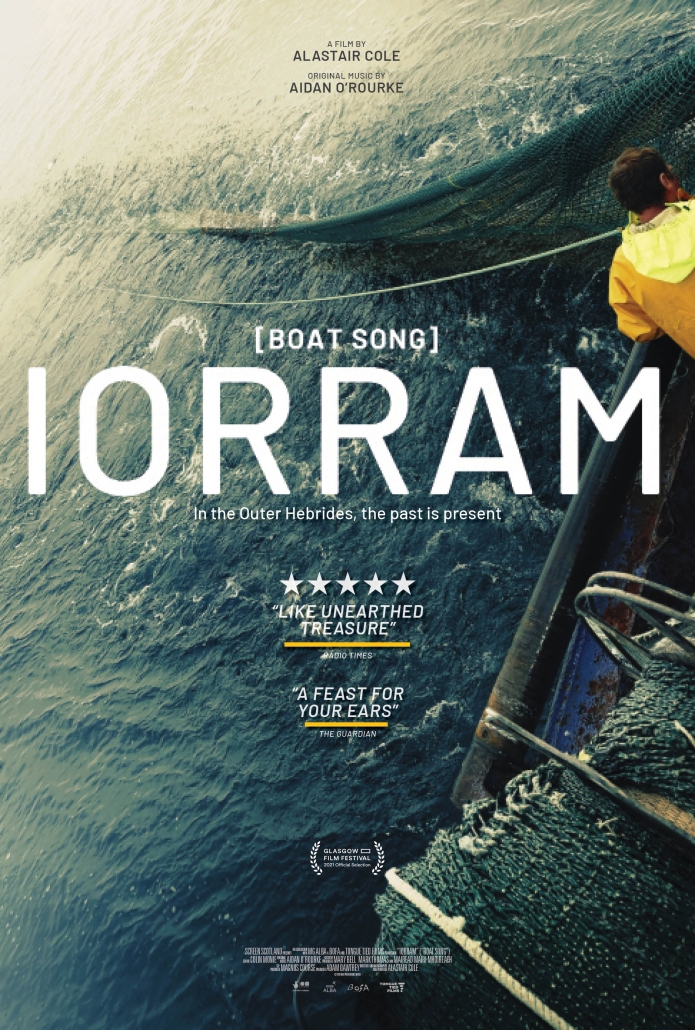
PHOTO 6 A film soundtrack always exists in two different states simultaneously. It can, of course, be consumed as a component part of a larger work of art – the film – but it is also always possible to listen to a soundtrack in isolation from its parent film, as a stand-alone album.
This gives soundtracks an inherent strangeness, an otherness. They create their own shadow-life: although the content is identical, the context renders the shadow different. A good soundtrack will function equally well as a backcloth for a film and as a listening experience in its own right. Whether or not a listener can participate in both sides of this dual existence depends on whether or not they have seen the film. Still, sometimes a soundtrack is so well-realised that you don’t necessarily need to participate in both sides.
Perhaps the magic of a good soundtrack comes from the tension implied by its two states, and you don’t always need to have seen the film to appreciate that tension. This is certainly the case with composer and fiddler Aidan O’Rourke’s score for the recent documentary film Iorram (Boat Song). Iorram, directed by Alastair Cole, is a deft, subtle and strangely moving portrayal of Gaelic-speaking Hebridean fishermen. Contemporary footage is underpinned by archival spoken material from nearly three-quarters of a century ago – a technique that gives the film its own double life.
As a result of this method of overlaying, the idea of time in the film becomes fluid, stretching out and doubling back so that the roles of fishermen past and present merge, shift and come in and out of focus. So O’Rourke’s soundtrack has to encapsulate both the modern and the antiquated, often simultaneously.
On Iorram, along with his fiddle playing, he takes on a role that falls somewhere between composer and curator. He has enlisted the help of some of contemporary folk’s leading lights, including Brighde Chaimbeul on smallpipes, cellist Lucy Railton, Thomas Gibbs on piano and harmonium, Graeme Stephen on guitar and Adam Kinner on sax. The result is a very free take on folk music, incorporating elements of jazz and modern composition in a way that is perfectly organic and entirely suited to the subject matter. O’Rourke is, without doubt, qualified for this particular project. His day job as one-third of iconic Scottish folk trio Lau – a band who have always had one eye on the future – sees him combine his fiddle with Kris Drever’s guitar and songcraft and Martin Green’s often experimental electronic wizardry
The Kaylana (Introduction), a minute-long instrumental, is a hypnotic, beautifully disconcerting swirl, punctuated towards its conclusion by a short, bright flare of fiddle. It casts a soft-edged shadow over the album – there is another minute-long iteration before a fully fleshed-out longer version. Then there’s the title track, which twinkles and shimmers like an impressionist painter’s interpretation of the sea, before a 1974 recording of Sorley MacLean reading his own Gaelic-language poem Reothairt (Spring Tide) introduces an air of quiet melancholy, strongly backed up by Stephen’s soulful electric guitar. The Herring Girls And The Barra Boys showcase Chaimbeul’s remarkable piping, high and wild against the drone of Gibbs’ harmonium.
Am Bòchdan is a stunning lesson in restraint: Backed by Railton’s sympathetic cello, a minimal piano melody from Gibbs winds around a vocal performance from Lizabett Russo that recalls the glossolalic heights of Liz Fraser. The song passes like a breeze but leaves a lasting impression.
O’Rourke’s musical pedigree isn’t the only thing that suits him for this project. He was brought up on the Scottish coast and witnessed first-hand the slow decline of the fishing industry. He brings his obvious love for the area into these compositions, and his affinity for the communities shines through particularly strongly on the songs featuring archival vocal material. He knows when to apply the lightest of touches, and on songs like Óran Nan Sgalpach (a 1968 recording of Harris fisherman Donald Alex MacDonald), he is content to let the voices do the talking to quietly stirring effect. The album’s centrepiece, Fuadaichean Nan Gaidheal/O Hó Hoireann ó, Tha Mi Ann Am Èiginn, is an eight and a half minute epic of shared memory and social history, examining the Highland Clearances and the subsequent poverty of rural Scotland and, in particular, its fishing industry. The tale is told through the spoken word of Peggy MacCuish (recorded in 1968) and the singing of Peggy MacLennan (1965). If it sounds dry or overly didactic, it really isn’t: the sheer passion in the women’s voices (as well as O’Rourke’s setting) makes for an incredibly moving listen.
O’Rourke is a master when it comes to building atmosphere: The Sandbank And The Whale slowly grows then falls away into nothingness before the gentle, pretty first notes of Fhir A’ Bhata/Nuair Thàinig Àm An Iasgaich lull the listener. The song’s final surprise is a vocal piece sung in 1951 by Peggy MacRae, which feels like it could have come from a much earlier musical generation. MacRae’s weathered voice comes up against the noises of the apparently outdoor setting in which it was recorded and the limitations of the recording equipment and still manages to shine through.
The Six Widows once again features the otherworldly beauty of Russo’s vocal – made all the more beguiling by some excellent studio trickery – in combination with the piano and delightfully off-kilter sax. The album closes with a reprise of the title track, a calm shimmer that recalls the sea after a storm. A fiddle melody breaks in part-way through then flits away again, the guitar lulls and soothes while barely-there vocals call out over the water. Then there is a wash of waves, a tidal white noise that ushers in the final, almost transcendental swell. It caps off a truly magical listening experience, one that, for all its outward quietness, is bursting with ideas and ripe with the history of an often neglected part of British culture. Even without the context of the film it accompanies, O’Rourke’s masterful document has a vividness that is almost visual in its own right.
It’s hard to imagine two more different places than New York and Great Yarmouth, but a film set in one recently helped to revive interest in a song about the other.
When The Boat Comes In, as a book version ,is definitely a good and useful companion to the tv series. It does not fully include every story line, but rather takes the main themes. In doing so it gives a deeper understanding of each of the main characters point of views, while still following the same general narrative. It becomes a fascinating view of the series creator’s subtly different shading of the characters behaviours from that on film. For instance in the TV series Jack seemed much closer to the Seaton family as a whole, even after him and Jessie broke up, almost to the point of obsession. In the book, he is friendly, especially with the mother, but gone are some of the more almost daily attempts to insert himself into their lives. The second and third book in the series continue the story up to the dramatic cliff hanger of the broadcast series second season. There is a fourth book written years later by James Mitchell’s son, Peter, but it picks up at a different point then the third televised season, called “Jack High”, and moves the mostly same group of characters with some additions in a different story direction (spoiler for television series 3).
The three books by James Mitchell are an interesting look into a different side of post WW1 Britain. Almost a flip side of Downton Abbey which shows a group of Upper Class basically decent people trying to navigate the social changes brought on by the war from the top of society. In ‘When the Boat Comes In”, you have working class people aspiring to move up based on financial achievement, their wits, and yes even merit. In telling us this it reminds us that industrialisation was casting a class divide throughout the country that was deemed by the politicians to be a land fit for heroes, after as had been promised before the war ended.
It fits right in here to our musical fishing lines because of its title music that it seemed the whole nation was singing at one time. When The Boat Comes In (or “Dance Ti Thy Daddy”) is a traditional English language folk song, listed as 2439 in the Roud Folk Song Index. The popular version originates in North East England. An early source for the lyrics, Joseph Robson’s “Songs of the bards of the Tyne“,[1] published 1849, can be found on the FARNE archive.[2] In FARNE’s notes to the song, it is stated that the lyrics were written by William Watson in about 1826.
It was popularised as the theme tune of the 1970s BBC drama serial When The Boat Comes In, in an arrangement by the composer David Fanshawe.
Lyrically, it tells a tale:
Dance to you Daddy, my little man.
Thou shalt have a fish and thou shalt have a fin
and thou shalt have a codlin
when the boat comes in.
Thou shalt have a fishie on a little dishie when the boat comes in
That seems to be a verse that could have been sung by a working class father to his son, celebrating the success of the fishing industry. That is not to say the industry was risk-free.
I had missed the Lesley Garrett recording that wee have finally settled on here, but this captures the song perfectly (and is again available on You Tube).
At the very heart of the cd we place two songs that take a panoramic view of the fishing industry, with a song by an old friend of mine, American songwriter Tom Pacheco and his composition Last Blue Whale In The Ocean. It was a song I used, with Tom´s permission, when working as a poet in schools, encouraging students to study and discuss its wider implications. the song laments the hunting to near extinction of some sea life and sits interestingly alongside a relatively recording by Skipinnish, a group from Scotland, called Last Of The Hunters.
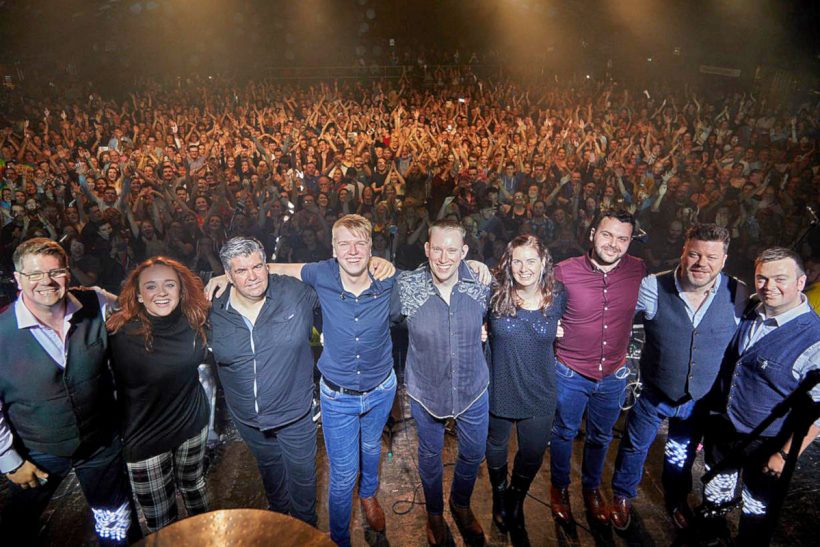
Top Scottish band Skipinnish has paid tribute to the fishing industry on its forthcoming album Steer by the Stars with a new song entitled Last of the Hunters.
The song traces different aspects of fishing history, and makes reference to various UK ports that were at one time bustling hives of activity, but are now, sadly, shadows of what they once were. The last verses of the song convey the determined strength in the industry, and the hope for the future, despite the adversity and the political mismanagement
The song was written by Skipinnish co-founder and ex-fisherman Angus MacPhail, from the Isle of Tiree. Angus’ father, the late Hector MacPhail, was a lobster fisherman, as was his uncle, Iain MacDonald. His brother Neil continues to fish crab and lobster from Tiree.
Angus said: “In many ways, the subject is too wide-ranging and complex to try to cover in one song, but I hope it at least gives a feeling of what has been unnecessarily lost over the years in so many communities around the UK and Ireland. There are very few industries that have been consistently treated so badly by successive governments.
“At the current time, when you get queues of misinformed celebrity chefs, environmentalists and journalists lining up to drag the industry down in the eyes of the general public, it creates a perfect climate for politicians to abuse it. I hope that, in a very small way, the song might do something to help gain a bit of public support for the fishing industry in these very uncertain political conditions.
“I also hope that it conveys how strong the industry remains, due to the resilience of fishermen themselves, despite the disgraceful way they have been treated to date by successive governments. However, it is just a song, and I hope that listeners – particularly fishermen – enjoy it.”
A fitting connection on the recording is that among the backing vocalists is retired skipper 81-year-old Alec Thorburn, originally of Fisherrow. Alec, of the boats Honestas and Green Pastures, is the great-uncle of Rory Thorburn Grindlay, who is the band’s drummer. Also, playing violin, as part of her string quartet backing arrangement, is Mhairi Marwick, niece of well-known retired skipper Dennis Slater, of Hopeman.
Last of the Hunters was performed for the first time at the Skipinnish 20th anniversary concert at Edinburgh’s Usher Hall on Saturday, 25 May 2019, and the album Steer By The Stars is available on I tunes
Steer By The Stars features on its front cover the well-known Tobermory creel boat Dawn Treader. Alasdair ‘Steptoe’ MacLean, skipper and owner of the Dawn Treader and a family friend of Angus’, was, coincidentally a nominee for Shellfish Fisherman of the Year at the Fishing News Awards at the time of the 2019 album being released,
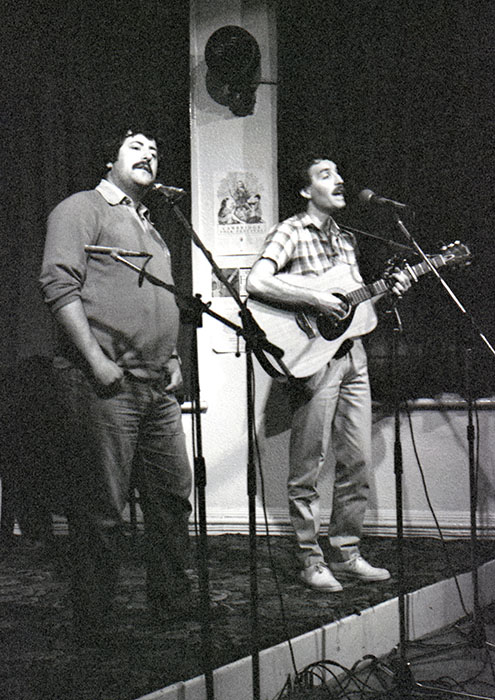
Colin Lever and I (left) wrote a couple of songs related to UK´s fishing industry for our folk duo, Lendanear, in the early nineteen eighties.
Fishes And Coal is really a Colin Lever song rather than a Lendanear collaboration, but I placed a comma more strategically in one of his lines and so earned a writing credit. It tells the story of a miner and a fisherman comparing notes on the hazards of their jobs and security, reviewing a fishing industry already well into decline and previewing a mining industry being that would be beaten to its death. Their conversation takes place at a real pit/head in Scotland, as the trawlerman tries to sell off his catch of the day to home-going pit-men on a Friday afternoon. The pit-head is no longer there !
A song that may not be about the fishing industry per se, but that certainly conjured up images of the ocean was one Colin and I heard sung in The Gallows Inn folk club at Milnrow every Tuesday by the incopmparable and still sadly missed Roy Barker. The song had been recorded by Steeleye Span by then, but Roy would sing it solo and unaccompanied, often at the end of the night whenever he was stand-in host, and the audience would swell the chorus like an ocean wave,… and at the end Roy would always raise his glass to us all, and offer a heart, ´Thanks. Well sung ´!
Last Boat Home is another Warwick / Lever song and one of only three lyrics I have written since I retired here to Lanzarote seven years ago. It is based on a tradition of house doors being painted a different colour if occupied by a widow of a man lost at sea from a fishing vessel.
The fishing industry is full of such inherent dangers, and to restore the industry to its former glory such dangers must be addressed and better health and safety regimes employed than those of the past.

Bread And Fishes was written by the late Alan Bell (right), a prolific writer of folk songs in the second half of the twentieth century, and was recorded by groups such as The Houghton Weavers. It is a re-telling of the Biblical tale of the feeding of the five thousand and beautifully reminds us that the fishing industry of that time was already providing nourishment for the poor and hungry.
Fisherman´s Friends, a folk group from Port Isaac in Cornwall recorded a lovely version of The Leaving Padstow Shanty (Padstow was a port for a fishing fleet long before pasties became famous and certainly Rick Stein helped gentrify Padstow with restaurants.

Having recorded a song about the putting out to sea, or leaving of the fishing fleet, Fisherman´s Friends also released a gorgeous version of The Mingulay Boat Song, about wives waiting in the harbour in another part of the UK for the safe return of their husbands working out at sea to feed the village.
https://blogs.loc.gov/folklife/2014/06/songs-of-the-abundant-ocean/
you could also visit www.lendanearmusic to check out
Meanwhile, though, Lanzarote continues to celebrate its industry and a dedicated Museum could certainly help us learn so much more about the history of our fishing industry.
Nevertheless, in other art forms, magnificent sculptures can be seen in Playa Honda and Puerto Callero, installed in public areas to commemorate Lanzarote´s relationship with the sea.
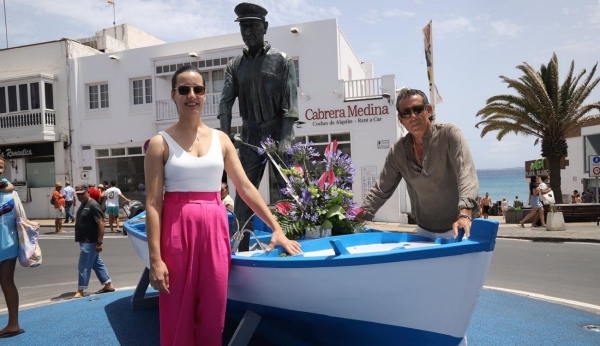
In fact, we reported recently, in an article still available in the archives of my daily Sidetracks And Detours blog, entitled Lanzarote Folk Set A Fine xample, that another interesting piece of work has been recently installed in the centre of Playa Blanca.
The creator Cintia Machin, (right) when unveiling her new work, made an emotional review of her personal life experience and her talks with the fishermen, who helped her sculpt the tribute. “It is a work that humanizes the public space and gives a sense of place, that refreshes the memory and that connects more with the feeling of our people,” she explained
I think Cintia is right to speak of her work ´connecting with the feeling of our people´. I would go further, though, and suggest that her works offer any tourist who can find the ´time to stand and stare´ to understand a little more of Lanzarote and Canary Island tradition and what life was like for previous generations here, before the planes brought the visitors. Cintia´s installations speak of the dignity of the men who caught food out on an often volatile ocean, and she captures the quietude of the working men, some of whom wrote poetry too to record their experiences.
Until recently, there was also a cemi-permanent exhibition, in Yaiza at Number Ten Gallery, of incredible metallic replicas of skeletons of some of the amazing creatures which can be found in the waters surrounding this island.(photo below). The exhibition has now moved elsewhere on Lanzarote, and if you see it you will be scared off for life from putting out to sea with your rod in your one man boat !
SIXTEEN ON THE WATER
playlist based on the global fishing industry
recommended by Sidetracks And Detours
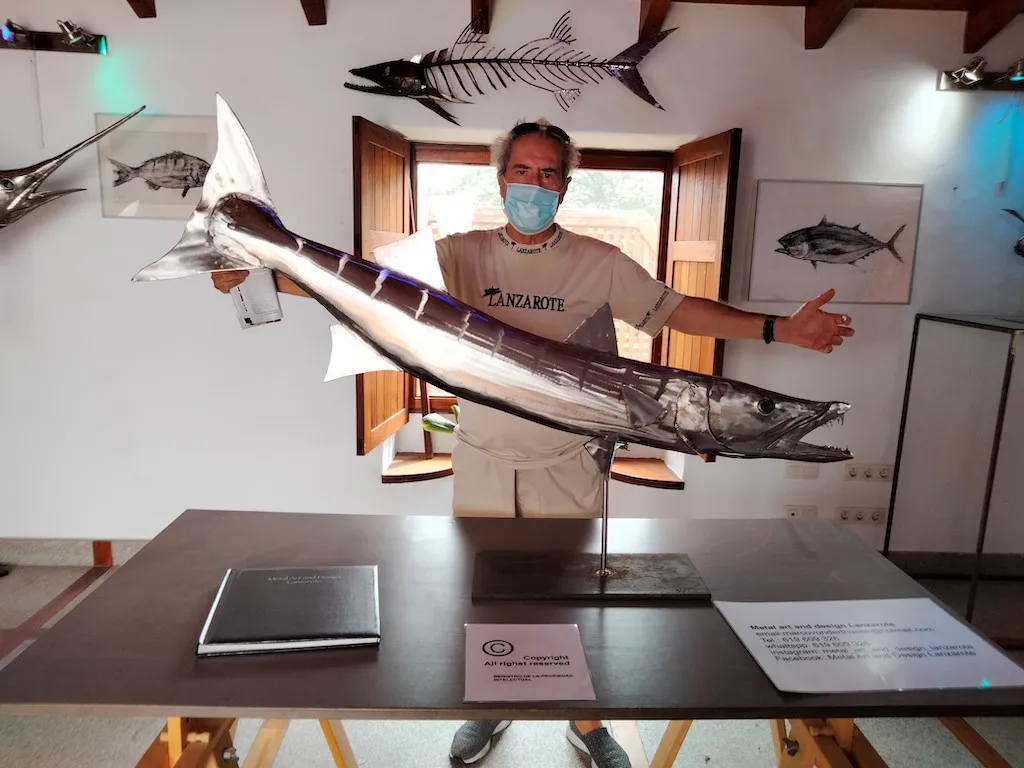
1 Sixteen On The Water
by Norman Warwick
2 Singing The Fishing
by Aiden O´Rourke
3 The Shoals Of Herring
by Punch Brothers
4 When The Boat Comes In
by Lesley Garrett
5 The Last Blue Whale In The Ocean
by Tom Pacheco
6 Last Of The Hunters
by Skippinish
7 Fishes and Coal
by Lendanear
8 Ranzo
by Roy Barker
9 Bread And Fishes
by Alan Bell
10 The Mingulay Boat song
by Fishermen´s Friends
11 The Leaving Padstow Shanty
by Fishermen´s Frineds
12 Last Boat Home *
by Lendanear
listing is © Sidetracks & Detours
- to find Last Boat Home on You Tube https://www.youtube.com/watch?v=c6N4xY4XSZg
- you can also find Fishes And Coal on the album Two Islands by Lendnaear at www.lendanearmusic

I´ve been racking my brains to think of a fishing related jazz number but only Summertime from Porgy and Bess comes to mind and that is pond fishing rather than sea fishing. There is, at a pinch, the one about Jonah He Lived In A Whale. It will, nevertheless, be worth listening to Steve Bewick´s Hot Biscuits jazz broadcast next week, as it features a live set from Manchester’s Counterpointmusic with Helen Pillinger, Carole Williams, Peter Hartley, Paul Hartley & Miles Pillinger at the Creative Space. There will also be adventurous sounds from Solstice, Wolverton Town Band, Paul Stephen Taylor, Georgina Jackson & Nottingham Jazz Orchestra. If this sounds interesting share with your friends and follow Steve on

AJ the DJ presents The Perfect Storm on Monster Radio on 99.9 fm tonight, Monday 22nd August at 5.00pm when her guest will be Lizzie Lane (left) described as an international singer and influencer. That sounds pretty interesting and i´ll be tuning in if I c an from here in the office. AJ is adept at drawing out stories from her guests. I know, I´ve been there. She sat mer down in her radio studio a few weeks ago and within minutes i was
Meanwhile Aileen Hendry, aka , AJ the FDJ at Monster Radio, has alerted Sidetracks And Detours to a new arts exhibition opening on Friday 26th August here on Lanzarote.
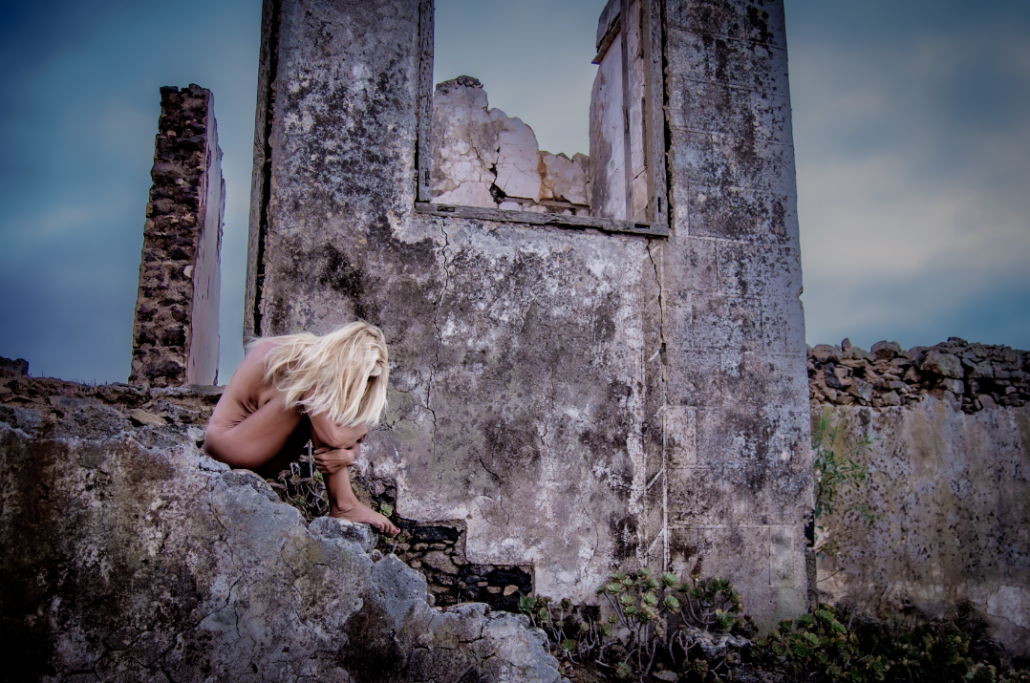
AJ also told us in a facebook message this morning about Adriyana Hodge, a Croatian born nude photographer who is exhibiting her work in Costa Teguise on Saturday the 27th August. It opens at 5 pm and runs until 10 pm with ticket holders being in with a chance to win a photoshoot with Adriyana. (see one of her works right)
Adriyana is a fascinating character who speaks perfect English, and Aj the DJ is sure the photographic artist will make an interesting subject for an interview .
She moved from Croatia to South Africa where she witnessed hold ups and car-jackings, so she came to Lanzarote, returning to South Africa only to bring her mum and sister and her nieces back to live here. However, she became caught in the lockdown in South Africa which, she says. was brutal.
Aj the Dj also tells us that Adriyana is an awesome photographer and. now settled here. wants to devote herself to making a full time career of her work.
The exhibition is in a new Spanish bar, Julie´s Tap Room in the Pueblo Marinero in Costa Teguise.
We look forward to bringing you a review of the inaugural showing.




Leave a Reply
Want to join the discussion?Feel free to contribute!